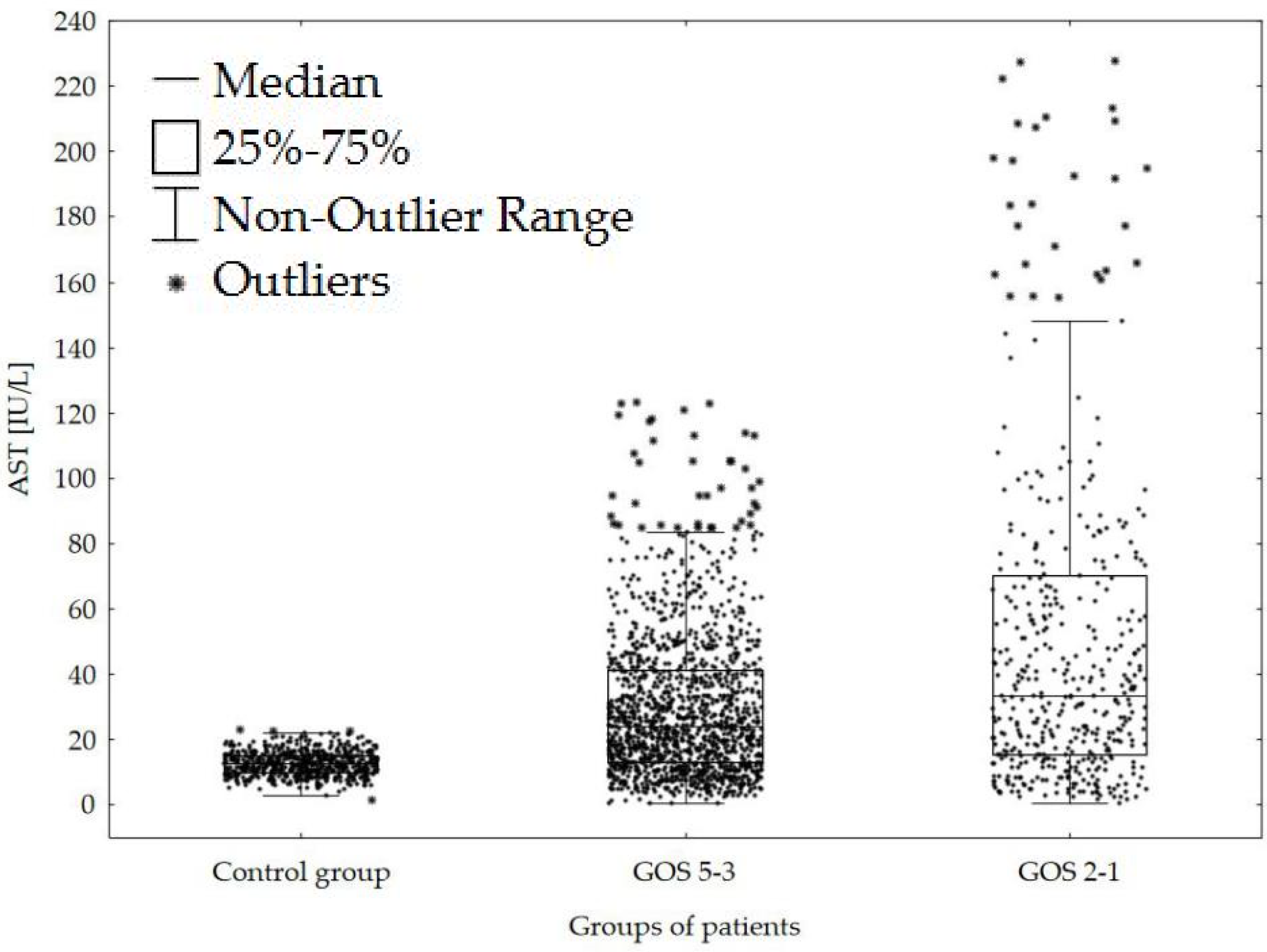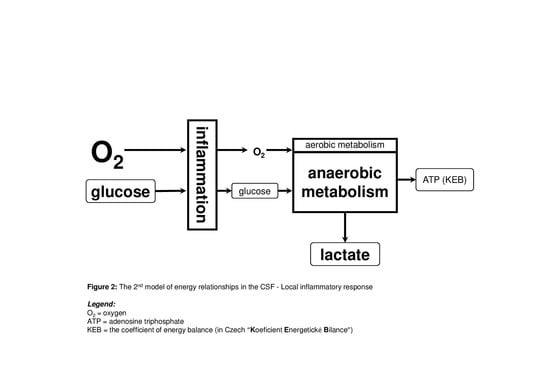Can Aspartate Aminotransferase in the Cerebrospinal Fluid Be a Reliable Predictive Parameter?
Abstract
:1. Introduction
2. Materials and Methods
2.1. Patients
2.2. CSF Analysis
2.3. Statistical Analysis
3. Results
4. Discussion
5. Conclusions
Author Contributions
Funding
Acknowledgments
Conflicts of Interest
Ethical Approval
References
- Hejčl, A.; Cihlář, F.; Smolka, V.; Vachata, P.; Bartoš, R.; Procházka, J.; Cihlář, J.; Sameš, M. Chemical angioplasty with spasmolytics for vasospasm after subarachnoid hemorrhage. Acta Neurochir. 2017, 159, 713–720. [Google Scholar] [CrossRef] [PubMed]
- Miller, B.A.; Turan, N.; Chau, M.; Pradilla, G. Inflammation, Vasospasm, and Brain Injury after Subarachnoid Hemorrhage. BioMed. Res. Int. 2014, 2014, 384342. [Google Scholar] [CrossRef] [PubMed] [Green Version]
- Provencio, J.J.; Fu, X.; Siu, A.; Rasmussen, P.A.; Hazen, S.L.; Ransohoff, R.M. CSF neutrophils are implicated in the development of vasospasm in subarachnoid hemorrhage. Neurocrit. Care 2010, 12, 244–251. [Google Scholar] [CrossRef] [PubMed] [Green Version]
- Sreekrishnan, A.; Dearborn, J.L.; Greer, D.M.; Shi, F.-D.; Hwang, D.Y.; Leasure, A.C.; Zhou, S.E.; Gilmore, E.J.; Matouk, C.C.; Petersen, N.H.; et al. Intracerebral Hemorrhage Location and Functional Outcomes of Patients: A Systematic Literature Review and Meta-Analysis. Neurocrit. Care 2016, 25, 384–391. [Google Scholar] [CrossRef]
- Tso, M.K.; Loch Macdonald, R. Acute Microvascular Changes after Subarachnoid Hemorrhage and Transient Global Cerebral Ischemia. Stroke Res. Treatment 2013, 2013, 425281. [Google Scholar] [CrossRef] [Green Version]
- Berger, R.P.; Pierce, M.C.; Wisniewski, S.R.; Adelson, P.D.; Clark, R.S.; Ruppel, R.A.; Kochanek, P.M. Neuron-specific enolase and S100B in cerebrospinal fluid after severe traumatic brain injury in infants and children. Pediatrics 2002, 109, e31. [Google Scholar] [CrossRef] [Green Version]
- Bonora, S.; Zanusso, G.; Raiteri, R.; Monaco, S.; Rossati, A.; Ferrari, S.; Boffito, M.; Audagnotto, S.; Sinicco, A.; Rizzuto, N.; et al. Clearance of 14-3-3 protein from cerebrospinal fluid heralds the resolution of bacterial meningitis. Clin. Inf. Dis. 2003, 36, 1492–1495. [Google Scholar] [CrossRef] [Green Version]
- Buée, L.; Bussiére, T.; Buée-Scherrer, V.R.; Delacourte, A.; Hof, P.R. Tau protein isoforms, phosphorylation and role in neurodegenerative disorders. Brain Res. Rev. 2000, 33, 95–130. [Google Scholar] [CrossRef]
- Hajduková, L.; Sobek, O.; Prchalová, D.; Bílková, Z.; Koudelková, M.; Lukášková, J.; Matuchová, I. Biomarkers of Brain Damage: S100B and NSE Concentrations in Cerebrospinal Fluid—A Normative Study. Biomed. Res. Int. 2015, 2015, 379071. [Google Scholar] [CrossRef] [Green Version]
- Kušnierová, P.; Zeman, D.; Hradílek, P.; Čábal, M.; Zapletalová, O. Neurofilament levels in patients with neurological diseases: A comparison of neurofilament light and heavy chain levels. J. Clin. Lab. Anal. 2019, 33, e22948. [Google Scholar] [CrossRef]
- Park, J.W.; Suh, G.I.; Shin, H.E. Association between cerebrospinal fluid S100B protein and neuronal damage in patients with central nervous system infections. Yonsei Med. J. 2013, 54, 567–571. [Google Scholar] [CrossRef] [PubMed]
- Townend, W.; Ingebrigsten, T. Head injury outcome prediction: A role for protein S100B? Trauma Outcomes 2006, 37, 1098–1108. [Google Scholar] [CrossRef] [PubMed]
- Green, J.B.; Oldewurtel, H.A.; O’Doherty, D.S.; Forster, F.M. Cerebrospinal Fluid Transaminase and Lactic Dehydrogenase Activities in Neurologic Disease. Arch. Neurol. Psychiatry 1958, 80, 148–156. [Google Scholar] [CrossRef]
- Laha, P.N.; Bhargava, K.D. CSF and serum GOT levels in CVA. J. Assoc. Physicians India 1964, 12, 427–430. [Google Scholar]
- Lutsar, I.; Haldre, S.; Topman, M.; Talvik, T. Enzymatic changes in the cerebrospinal fluid in patients with infections of the central nervous system. Acta Paediatr. 1994, 83, 1146–1150. [Google Scholar] [CrossRef] [PubMed]
- Parakh, N.; Gupta, H.L.; Jain, A. Evaluation of enzymes in serum and cerebrospinal fluid in cases of stroke. Neurol. India 2002, 50, 518–519. [Google Scholar]
- Pecháň, I. Enzymology of the cerebrospinal fluid. Cesk. Neurol. Neurochir. 1989, 52, 11–21. [Google Scholar]
- Riemenschneider, M.; Buch, K.; Schmolke, M.; Kurz, A.; Guder, W.G. Diagnosis of Alzheimer’s disease with cerebrospinal fluid tau protein and aspartate aminotransferase. Lancet 1997, 350, 784. [Google Scholar] [CrossRef]
- Tapiola, T.; Lehtovirta, M.; Pirttilä, T.; Alafuzoff, I.; Riekkinen, P.; Soininen, H. Increased aspartate aminotransferase activity in cerebrospinal fluid and Alzheimer’s disease. Lancet 1998, 352, 287. [Google Scholar] [CrossRef]
- Kelbich, P.; Procházka, J.; Sameš, M.; Hejčl, A.; Vachata, P.; Hušková, E.; Peruthová, J.; Hanuljaková, E.; Špička, J. Basic principles and specifics of cerebrospinal fluid evaluation in neurosurgical and neurointensive care patients (Part I: Introduction). Klin. Biochem. Metab. 2011, 19, 223–228. [Google Scholar]
- Karlson, P. Kurzes Lehrbuch der Biochemie für Mediziner und Naturwissenschaftler, 10th ed.; Georg Thieme Verlag: Stuttgart, Germany, 1977. [Google Scholar]
- Hintze, J. NCSS, PASS, and GUESS; NCSS Statistical Software: Kaysville, UT, USA, 2006. [Google Scholar]
- Kenward, M.G.; Roger, J.H. Small sample inference for fixed effects from restricted maximum likelihood. Biometrics 1997, 53, 983–997. [Google Scholar] [CrossRef] [PubMed] [Green Version]
- Kelbich, P.; Koudelková, M.; Machová, H.; Tomaškovič, M.; Vachata, P.; Kotalíková, P.; Chmelíková, V.; Hanuljaková, E. Importance of urgent cerebrospinal fluid examination for early diagnosis of central nervous system infections. Klin. Mikrobiol. Inf. Lék. 2007, 13, 9–20. [Google Scholar]
- Kelbich, P.; Hejčl, A.; Selke Krulichová, I.; Procházka, J.; Hanuljaková, E.; Peruthová, J.; Koudelková, M.; Sameš, M.; Krejsek, J. Coefficient of energy balance, a new parameter for basic investigation of the cerebrospinal fluid. Clin. Chem. Lab. Med. 2014, 52, 1009–1017. [Google Scholar] [CrossRef] [PubMed]
- Adam, P.; Táborský, L.; Sobek, O.; Hildebrand, T.; Kelbich, P.; Průcha, M.; Hyánek, J. Cerebrospinal fluid. In Advances in Clinical Chemistry, 1st ed.; Academic Press: San Diego, CA, USA; San Francisco, CA, USA; New York, NY, USA; Boston, MA, USA; London, UK; Sydney, Australia; Tokyo, Japan, 2001; pp. 1–62. [Google Scholar]
- Donato, R.; Cannon, B.R.; Sorci, G.; Riuzzi, F.; Hsu, K.; Weber, D.J.; Geczy, C.L. Functions of S100 Proteins. Curr. Mol. Med. 2013, 13, 24–57. [Google Scholar] [CrossRef] [PubMed] [Green Version]

| Days | GOS 5–3 Number of Patients = 167 Number of Samples = 1497 | GOS 2–1 Number of Patients = 48 Number of Samples = 459 | Bonferroni p Values (Significance Level α = 0.05) |
|---|---|---|---|
| Estimated Mean of AST (S.E.M.) IU/L Number of Patients/Samples | Estimated Mean of AST (S.E.M.) IU/L Number of Patients/Samples | ||
| Normal Value ≤ 18.0 IU/L [17] | |||
| 2 | 36.6 (9.6) 78/156 | 117.0 (17.4) 33/65 | 0.001 |
| 4 | 36.0 (9.0) 106/186 | 119.4 (17.4) 27/51 | <0.001 |
| 7 | 35.4 (9.0) 125/295 | 121.8 (16.8) 32/82 | <0.001 |
| 9 | 34.8 (9.0) 115/192 | 123.6 (16.8) 29/51 | <0.001 |
| 12 | 34.2 (9.0) 105/228 | 126.6 (17.4) 30/68 | <0.001 |
| 14 | 33.6 (9.0) 76/125 | 128.4 (17.4) 23/40 | <0.001 |
| 17 | 33.0 (9.6) 67/161 | 131.4 (18.0) 24/54 | <0.001 |
| 20 | 32.4 (10.2) 64/154 | 134.4 (19.2) 19/48 | <0.001 |
© 2020 by the authors. Licensee MDPI, Basel, Switzerland. This article is an open access article distributed under the terms and conditions of the Creative Commons Attribution (CC BY) license (http://creativecommons.org/licenses/by/4.0/).
Share and Cite
Kelbich, P.; Radovnický, T.; Selke-Krulichová, I.; Lodin, J.; Matuchová, I.; Sameš, M.; Procházka, J.; Krejsek, J.; Hanuljaková, E.; Hejčl, A. Can Aspartate Aminotransferase in the Cerebrospinal Fluid Be a Reliable Predictive Parameter? Brain Sci. 2020, 10, 698. https://doi.org/10.3390/brainsci10100698
Kelbich P, Radovnický T, Selke-Krulichová I, Lodin J, Matuchová I, Sameš M, Procházka J, Krejsek J, Hanuljaková E, Hejčl A. Can Aspartate Aminotransferase in the Cerebrospinal Fluid Be a Reliable Predictive Parameter? Brain Sciences. 2020; 10(10):698. https://doi.org/10.3390/brainsci10100698
Chicago/Turabian StyleKelbich, Petr, Tomáš Radovnický, Iva Selke-Krulichová, Jan Lodin, Inka Matuchová, Martin Sameš, Jan Procházka, Jan Krejsek, Eva Hanuljaková, and Aleš Hejčl. 2020. "Can Aspartate Aminotransferase in the Cerebrospinal Fluid Be a Reliable Predictive Parameter?" Brain Sciences 10, no. 10: 698. https://doi.org/10.3390/brainsci10100698
APA StyleKelbich, P., Radovnický, T., Selke-Krulichová, I., Lodin, J., Matuchová, I., Sameš, M., Procházka, J., Krejsek, J., Hanuljaková, E., & Hejčl, A. (2020). Can Aspartate Aminotransferase in the Cerebrospinal Fluid Be a Reliable Predictive Parameter? Brain Sciences, 10(10), 698. https://doi.org/10.3390/brainsci10100698






